The Dynamic Connection Between Sofas and Coffee Tables
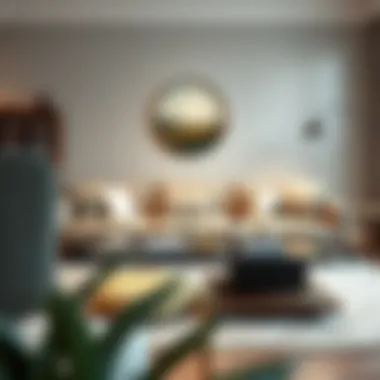

Intro
When it comes to the heart of the home, the living room often takes the cake. A cozy sofa paired with a stylish coffee table can transform an ordinary space into a well-thought-out haven. Yet, the magic doesn't stem solely from the individual pieces; it's the dynamic interaction between sofa and coffee table that creates a cohesive atmosphere. This guide dives into the critical factors that define this relationship, examining everything from design trends to practical considerations. Whether you're a seasoned interior decorator or a DIY enthusiast, understanding the essential pairing of these two furniture staples can elevate your living area to new heights.
Furniture Design Trends
Current Styles and Themes
In today's design landscape, there seems to be a mesh of various styles that influence the way we furnish our homes. From mid-century modern to minimalist Scandinavian pieces, each trend brings something unique to the table—quite literally. Sofas with clean lines combine smoothly with all sorts of coffee tables, creating an inviting space conducive for gatherings or quiet evenings. The eclectic bohemian style also finds its footing here, where a vintage sofa pairs with an artisanal coffee table, hinting at a story beneath their surface.
Additionally, the re-emergence of retro designs calls on vibrant colors and quirky patterns. A plush, mustard-colored sofa can find a perfect counterpart in a round, glass coffee table with golden accents to balance out the retro vibe.
Color Palettes and Materials
The hues you choose speak volumes; soft pastels can evoke a calming atmosphere, while bold colors make a statement. For instance, a deep navy sofa works wonders when matched with a sleek white marble coffee table, creating a striking contrast that draws the eye. Meanwhile, earthy tones are making waves, with terracotta and olive greens being particularly popular. Pairing a brown leather sofa with a reclaimed wood coffee table respects this natural vibe.
In terms of materials, wood and metal are timeless. A chunky wooden coffee table* lends warmth and character, especially when paired with a fabric sofa, highlighting the texture. On the flip side, a metal-framed coffee table adds an industrial edge, which can be softened by a plush sectional. The key is in balancing these materials to create harmony.
Practical Furniture Tips
How to Choose the Right Size
Sizing matters when it comes to furniture. A coffee table too small can be easily overlooked, while one too large might overwhelm your sofa and space. Typically, the height of a coffee table should be within 2-4 inches of the height of the sofa cushion. As a rule of thumb, aim for about 18 inches between the sofa and coffee table for optimal legroom.
Consider the layout of the room; an open floor plan allows for more freedom in choosing larger tables while a compact space might benefit from a smaller, round table that doesn’t impose too much.
Maintenance and Care for Longevity
Finally, taking care of your selected pair ensures they stand the test of time. For fabric sofas, regular vacuuming and the occasional professional clean can help maintain their luster. Leather pieces require conditioning to prevent cracks; think of it like moisturising your skin. As for coffee tables, a simple wipe-down with a damp cloth every now and then goes a long way—avoid harsh chemicals, which can dull finishes over time.
"Investing in quality furniture is not just a purchase; it's a commitment to enhancing your living experience."
For anyone looking to enhance their living space, understanding the synergy between the sofa and coffee table is crucial. Through thoughtful selection and consideration of the trends, you can create a more inviting and aesthetically pleasing environment.
Foreword to Sofa and Coffee Table
The pairing of a sofa and a coffee table is one of those quintessential aspects that can either make or break a living room. It's about more than just having a place to set your drink; it's about how these furniture pieces interact with each other and contribute to the overall vibe of the space. The right combination not only enhances the aesthetics of your living area but also molds how the space feels and functions.
When selecting a sofa and coffee table, homeowners and designers alike often think of style first—modern, minimalist, traditional. However, there are deeper considerations at play. The angle of the sofa, the height of the table, the materials used, and even the color scheme are all part of a delicate dance that creates visual harmony and functional balance. Think of it as a relationship; just as in human dynamics, compatibility matters.
The Role of Furniture in Interior Design
Furniture serves as the backbone of any living space. It holds stories, functions, and memories, all while defining the spatial layout. Sofas provide seating and comfort, while coffee tables serve multiple roles, from simple surfaces to storage solutions and even decorative elements that can anchor a room's aesthetic.
The right sofa can invite people to sit down for a chat, while an ill-placed coffee table can disrupt the flow, making movement challenging. To put it plainly, a cozy couch facing a well-chosen coffee table sets a scene for relaxation or entertainment.
It’s essential to recognize that good furniture choices reflect personality too. A velvet chesterfield paired with a rustic wooden table can tell a tale of old-world charm and comfort, while a sleek leather sofa juxtaposed with a glass top table speaks to a modern sophistication.
Defining the Living Room’s Purpose
Before you even think about what to buy, you need to answer a fundamental question: What is the living room for? Is it a hangout for family movie nights, a sophisticated space for hosting, or perhaps a cozy nook for reading? The purpose of your living room significantly influences how you choose your sofa and coffee table.
For a relaxed family-friendly environment, opt for durable, easy-to-clean materials and a coffee table sturdy enough to withstand the clumsiness of kids. On the flip side, if it's more about entertaining guests, you might prioritize elegance and style over functionality.
Ultimately, defining the living room's purpose sets the stage for choosing complementary pieces that work well together, enhancing the overall experience rather than detracting from it. By thoughtfully considering these elements, you create a space that is not only aesthetically pleasing but also aligned with how you intend to use the room.
"Furniture is not just a collection of pieces; it’s a language that speaks volumes about who you are and how you live."
In sum, the collaboration between a sofa and coffee table is pivotal in creating a well-rounded living space. Understanding these dynamics prepares you to make informed choices that elevate your interior design game.
Understanding Design Aesthetics
Design aesthetics play an indispensable role in creating a living space that resonates with comfort and style. When considering the relationship between a sofa and a coffee table, aesthetics elevate mere functionality to a level where visual appeal becomes crucial. The interaction betwen these two pieces can shape the atmosphere of the room, as they often serve as focal points that draw the eyes and set the tone for entire living areas.
In understanding design aesthetics, it’s helpful to recognize the key elements and benefits involved. A well-paired sofa and coffee table arrangement not only looks attractive but also fulfills practical roles in daily life, making it easier to entertain guests or unwind after a long day. Thoughtful consideration of these elements will yield a space that feels both inviting and coherent.
Complementing Styles: Modern vs. Traditional
Choosing between modern and traditional styles often boils down to personal taste. Modern designs are marked by clean lines, simplicity, and a minimalist ethos. They favor functionality without excessive ornamentation. Consider, for example, a sleek, low-profile sofa paired with a geometric coffee table made of glass or metal. This type of pairing creates an airy feel that is often desired in contemporary homes.
On the other hand, traditional styles lean towards ornate details and more classical silhouettes. Imagine a plush, tufted sofa with intricate woodwork, accompanied by a round, carved coffee table. Such a combination can evoke warmth and a sense of history in your space, making it feel more lived-in and inviting. Integrating elements of both styles can lead to an eclectic yet coherent arrangement, highlighting how versatility can enhance design aesthetics.
Color Schemes and Visual Balance
Color schemes are another pivotal aspect when it comes to design aesthetics between a sofa and coffee table. The right color palette not only enhances visual balance but can also significantly affect mood and perception of space.
- Monochromatic Schemes: Sticking to one color family can provide a sleek, unified appearance. For instance, gray tones in a soft sofa paired with a charred oak coffee table can create a soothing backdrop.
- Contrasting Colors: Using bold contrasts can inject energy into a space. A bright teal sofa alongside a warm, earthy-toned coffee table can establish a dynamic and playful environment.
- Neutral Foundations: A neutral-colored sofa enables more freedom in introducing a variety of coffee table styles. For example, a beige sectional opens up room for a dark wood or metallic coffee table, pulling the gaze and creating visual interest without overwhelming the senses.
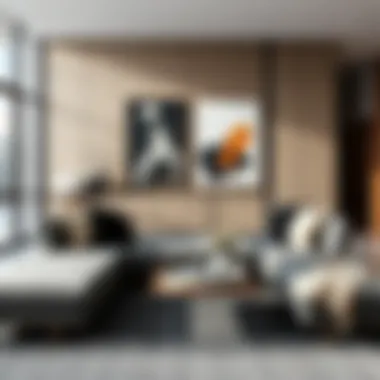
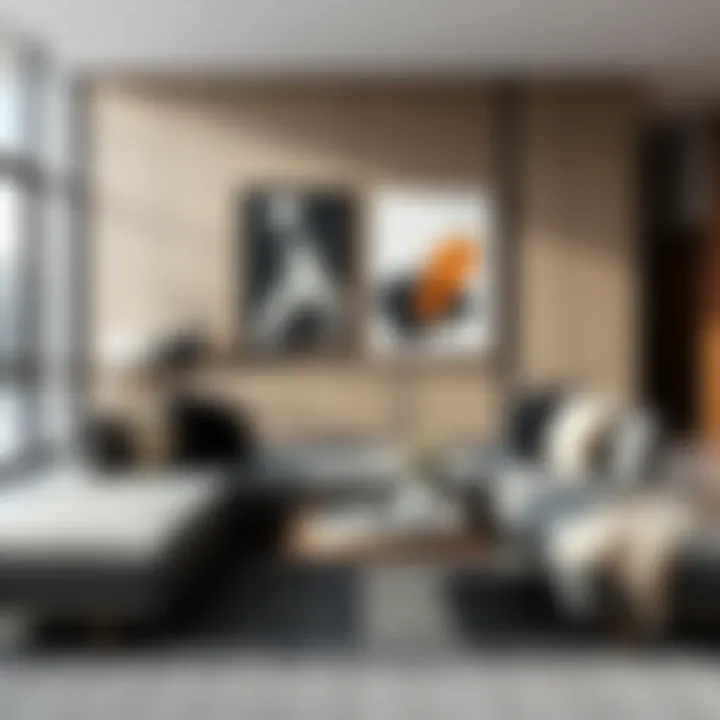
When selecting colors, think also about the lighting in the room and its effects. Natural light will accentuate certain hues more than others, while artificial lighting can shift the appearance of colors. Always experiment with samples in-situ to find what best dances with your space.
"A harmonious balance between color and style often elevates functionality into art."
By paying attention to design aesthetics, you can make empowered choices that not only enhance the beauty of your living space but also reflect your personal style, making your home your own sanctuary.
Material Considerations
The choice of materials for both sofas and coffee tables is crucial, not just from an aesthetic perspective but also in terms of functionality and longevity. Getting this aspect right can elevate the entire living space. You want to make choices that not only look stunning but also serve practical purposes for years to come. A well-thought-out selection of materials can enhance your living room’s comfort and visual impact while influencing maintenance routines and the durability of your pieces.
Wood, Metal, and Glass Options
When it comes to materials, each option has its own set of characteristics and benefits. Let’s break down the trio that often dominates the market: wood, metal, and glass.
- Wood: This is a classic choice that brings warmth and texture to a living room. Hardwood like oak or walnut can withstand wear and tear, making it an excellent long-term investment. However, the type of wood matters. While softwoods like pine may be more affordable, they might not withstand the test of time quite as well.
- Metal: Often used for legs or frames, metal can exude a modern vibe. Materials such as stainless steel or wrought iron offer durability and a sleek aesthetic. Metal can also lend a bit of industrial flair, especially when paired with rugged fabrics.
- Glass: Glass coffee tables can provide an airy feel and a sense of spaciousness, especially in smaller rooms. Tempered glass is a safe option because it is resistant to scratches and breakage. However, it requires regular cleaning and might not be ideal for households with small children due to safety concerns.
These material choices are foundational, shaping how the items interact visually and functionally in your space, and potential combinations can yield results that dazzle the eye.
Durability and Maintenance
Durability is another aspect that should be at the forefront of your considerations. Sofas and coffee tables are daily-use items, and, as such, they need materials that can hold up.
- Wood: Protective finishes can add to the lifespan of wood items. Regular polishing can also keep the grain looking beautiful. It's worth looking for woods that naturally resist moisture and pests for added longevity.
- Metal: Generally, metals require minimal upkeep. A simple wipe-down with a damp cloth typically suffices. However, keep an eye on rust if exposed to humidity. Some metals also have finishes that can wear off and may need periodic reapplication.
- Glass: This material can be the trickiest when it comes to maintenance. It requires consistent cleaning but offers a stunning look that many find worth the effort. Pay attention to edges and joints, which can be weak points in some glass furniture.
Choosing the right materials isn't merely about style; it's about selecting pieces that can endure the rhythms of life while maintaining their beauty.
Materials truly form the backbone of your sofa and coffee table pairing. Selecting wisely sets the stage for durability, ease of maintenance, and an enduring impact on your living environment.
Functional Dynamics of Sofa and Coffee Table
In the intricate dance of interior design, the functional dynamics of a sofa and coffee table cannot be overstated. These two pieces not only serve as the focal point in many living spaces but also define how a room is experienced. Understanding their interaction lays the groundwork for a well-thought-out arrangement that enhances both aesthetics and usability.
When considering these items, one must look beyond mere aesthetics; it’s about how they work together seamlessly. The coffee table should complement the sofa, taking into account its height, depth, and style. Imagine a sleek, modern sectional paired with a rustic wooden table. There’s a disconnect there, even if each piece is individually appealing. Hence, a coherent design demands attentiveness to practical aspects as much as to style.
Hierarchy of Space: Positioning and Proportions
Positioning these elements properly within a living room can make or break the overall atmosphere. The hierarchy within space is fundamentally about creating an order where focus naturally gravitates. First, one needs to determine the primary factors that govern this arrangement:
- Proportions: The scale of your coffee table should be considered in relation to the sofa. A towering table across a low, plush sofa creates an awkward dynamic, while a coffee table that aligns closely with the sofa's height fosters a natural flow.
- Arrangement: Pulling the coffee table close enough allows for easy access; however, leaving sufficient space to navigate around it ensures comfort. Roughly 18 inches is often recommended between the sofa and table, but this can vary based on personal preference and space constraints.
- Visual Lines: How do your eyes move across the room? Creating lines with the arrangement can guide viewers' attention. A round coffee table can soften straight lines from rectilinear sofas, fostering an inviting atmosphere.
This nuanced balance between height and space not only dictates practicality but affects overall comfort in the living area, thus creating a harmonious setup beyond just the visual appeal.
Accessibility and Usability
The usability of furniture is paramount. A coffee table’s role extends beyond being a perch for drinks; it should also facilitate interaction among those seated. An accessible table should be positioned to allow easy reach from the sofa.
- Multi-Functionality: In smaller spaces, consider a coffee table with a dual purpose, such as one that features storage. This can keep the surface clear and usable while offering practical storage solutions for books or games.
- 2019 Study Findings: A recent survey found that 74% of homeowners prioritize usability over aesthetic appeal when selecting furniture for their living room (source: Smith & Co). This further reinforces the significance of usability; making sure your furniture does its job without sacrificing style.
- Casual Layouts: Especially in informal settings, arranging the coffee table at an angle can enhance accessibility while creating a more relaxed, homey vibe rather than a rigid, traditional setup.
In summary, understanding the functional dynamics between a sofa and a coffee table is not just about design; it’s about crafting an experience that prioritizes comfort, usability, and interaction. By thoughtfully considering positioning and accessibility, you can create a living area that is not only visually appealing but also welcoming and inviting.
Trends in Sofa and Coffee Table Pairings
The world of interior design is always in flux. Trends shift with the seasons, and what was once in vogue can quickly fall out of favor. Understanding trends in sofa and coffee table pairings is essential for creating a living space that feels current and stylish. These trends influence not just the aesthetic but also the functionality of your space. Homeowners and decorators alike should take note of these trends as they can lead to more cohesive designs and improved usability in a living area.
Minimalist Approaches
Minimalism isn't simply about having less; it’s about simplicity and efficiency in design while maintaining a sense of beauty. This approach tends to favor clean lines and a muted color palette. When it comes to pairing sofas and coffee tables, the minimalist trend encourages the selection of pieces that have a strong, yet understated presence. For instance, a low-profile, neutral-toned sectional can work very well with a sleek glass coffee table. This combination allows the eye to flow effortlessly across the room, reducing visual clutter.
Key Elements of Minimalist Pairings:
- Focus on Functionality: Every piece should have a purpose. Whether the coffee table is for drinks or as a footrest, it should serve a function beyond just decoration.
- Muted Color Schemes: Earth tones or monochromatic palettes help create a serene environment without overwhelming senses.
- Simple Shapes: Opting for geometric shapes can add an interesting visual without compromising the minimalist ethos.
Using minimalist design can often lead to a calming atmosphere, perfect for unwinding after a long day. Additionally, this trend accommodates flexibility in a room’s function, allowing the space to be easily adapted to gather friends or simply enjoy a quiet evening.
Eclectic Mixing Styles
On the opposite end of the spectrum lies the eclectic mix, celebrated for its ability to harmoniously blend various styles, colors, and textures. This trend encourages creativity and personal expression through furniture. Imagine a plush vintage velvet sofa paired with a rustic wooden coffee table, or a sleek modern couch alongside a quirky, bohemian-styled table. Each piece tells a story while contributing to a well-rounded aesthetic.
Considerations for Eclectic Pairings:
- Complementary Colors and Textures: Although mixing styles is key, maintaining a cohesive color palette can tie the look together. This creates a sense of balance amid the variety.
- Layering: Don't shy away from layering—mixing materials such as wood and metal or combining soft and hard surfaces can add depth and interest.
- Highlighting Personal Style: Let your individuality shine through. Incorporate elements that reflect your personality, including art, decor, or even unexpected pieces that stand in contrast to the main elements.
Mixing styles can invigorate a living area, creating a space that is not only functional but also rich in character. This trend invites experimentation, making it an exciting opportunity for homeowners and decorators to play with their decor choices.
“You can only create greatness with a canvas full of possibilities.”
In summary, the trends in sofa and coffee table pairings speak to distinct philosophies in design. Whether one leans towards minimalism or a more eclectic mix, recognizing these trends allows for greater creativity and personalization in living spaces. As always, the most important thing is selecting pieces that not only fit the current trends but also resonate with your lifestyle and vision for your home.
Cohesion in Design


In the symphony of interior design, cohesion acts as the conductor, guiding every element to create a harmonious arrangement. When it comes to the pairing of sofas and coffee tables, the necessity of cohesion cannot be understated. Every piece of furniture, from the softest cushion to the most robust table, should resonate with a unified aesthetic. This harmony allows not only for visual appeal but also for an inviting atmosphere that encourages soft conversations and comfortable gatherings.
The key to achieving cohesion in design lies in understanding the theme of your space. Are you leaning towards a minimalist vibe, or do you prefer a more eclectic mixture? Having a clear vision helps streamline your choices as you pick out furniture and accents. Whether it’s the sleek lines of a contemporary coffee table paired with a plush, oversized sofa or a rustic table crafted of reclaimed wood positioned alongside a modern sectional, keeping a consistent theme ensures that your living area feels intentional and curated.
Here are some essential benefits of maintaining cohesion in your furniture pairing:
- Aesthetic Unity: Cohesion enhances the overall beauty, bringing together various elements under a common umbrella.
- Improved Functionality: When furniture pieces work well together, they create a more functional space, allowing for ease of movement and satisfactory use.
- Enhanced Comfort: A well-coordinated layout not only looks appealing but can also feel more welcoming and comfortable for family and guests.
Cohesion in design brings forth a multitude of considerations. One must think about color schemes, textures, and proportions when selecting each piece. Pairing a dark leather sofa with a glass coffee table can create a striking contrast, but it may require a few lighter elements, like a neutral rug or a few light wooden accessories, to tie the whole look together.
Ultimately, the key to cohesion lies in the relationship between the sofa and coffee table. Each piece should relate to the others in style, color, and material, creating a dialogue rather than a disjointed conversation.
Creating a Harmonious Look
In designing a harmonious look for your living room, it’s about more than just matching colors. A truly harmonious space requires careful consideration of the shapes, sizes, and materials of the sofa and coffee table. It’s about creating a visual flow that draws the eye naturally through the room.
Consider the dimensions of both the sofa and the coffee table. A bulky coffee table can overwhelm a small sofa, making the space feel cramped. On the other hand, an oversized sofa may dwarf a dainty coffee table, leading to a disjointed appearance. Ideally, the size of your coffee table should align with the scale of the sofa, both in height and volume. General rules suggest leaving a width of about 18 inches between the two to allow for easy movement.
Another aspect to ponder is the visual characteristics, such as color and texture:
- Color Harmony: Selecting hues that complement one another can elevate the look. Think about using varying shades of the same color family or combining contrasting colors that remain within the same emotional palette.
- Form and Shape: The shapes of your furniture can also contribute to visual harmony. Pairing a round coffee table with a sectional sofa creates a welcoming space that is easy to navigate, while rectangular forms can lend a more formal touch.
Through a mixture of cohesive elements, the living room can transform into a space that feels intentional, balanced, and inviting, where the sofa and coffee table enhance each other rather than compete for attention.
The Importance of Textures
Textures play a pivotal role in achieving cohesiveness in sofa and coffee table dynamics. They add depth and interest, making a space feel more inviting and layered. Each element in the room—from the fabric of the sofa to the finish of the coffee table—should be considered not only for its visual impact but also for its tactile quality.
Different textures can create contrast while still working together harmoniously. For instance, a soft, upholstered sofa can be beautifully complemented by the sleek, smooth surface of a marble coffee table. This juxtaposition not only catches the eye but also engages the senses, providing a touchable experience in the living space.
Here are a few textures to consider, along with their potential combinations:
- Soft Fabrics: The plush feel of velvet or linen on a sofa can brighten up a firm wooden or metal table.
- Natural Elements: Incorporating materials like rattan or wicker through decorative accents or side tables can add an organic touch, softening the overall aesthetic.
- Mixed Materials: Combining softer elements with harder surfaces, such as a leather sofa paired with a glass-topped table, can lend the space an air of sophistication.
Ultimately, thoughtful consideration of textures helps in bringing the room to life, adding richness and a sense of comfort. This layer of complexity, when aligned with other elements of design, advances the overall idea of cohesion, ensuring that each piece contributes to a unified and welcoming atmosphere.
"The soul of interior design lies not just in style, but in the details that create a deeply resonant and inviting environment."
Budget-Friendly Options
When furnishing a living space, the cost can often feel like a heavy anchor pulling you down. But it doesn't have to be that way. Exploring budget-friendly options for sofas and coffee tables is about doing more than just saving a few bucks; it’s about making smart choices that don’t skimp on style or functionality. The importance of this topic lies in the ability to create a warm, inviting atmosphere without draining your wallet.
Affordable Materials and Designs
Many people assume that upscale materials equate to better quality. This is, in part, true but let’s not overlook how creativity can stretch your budget. Consider pieces made from engineered wood or even particle board. Often, these materials are surprisingly durable and can look quite attractive with the right design.
- Laminate Finishes: Available in a range of colors and patterns, laminate allows for stylish surfaces that mimic natural textures without the hefty price tag.
- Textiles: Dive into the realm of versatile fabrics like microfiber or polyester blends. These materials can withstand daily wear and are much easier to care for than some luxe textiles.
- Functional Aesthetics: Look for designs that prioritize multipurpose capability. For instance, a coffee table with hidden storage or one that converts into a desk is not just economical but also elevates utility.
A bit of creativity with these affordable materials can help you score a look that rivals high-end designs. Don't underestimate the power of a well-placed throw or an artful arrangement of decor to transform a simple piece.
Second-Hand and Vintage Finds
In the treasure hunt that is second-hand shopping, each find tells a story. This is not just about chancing upon a good deal; it’s tapping into a world of character and nostalgia that new pieces often lack. Whether raiding a local thrift shop or browsing an online marketplace like Facebook Marketplace, the second-hand furniture market is rich with potential.
- Unique Pieces: Vintage sofas and coffee tables often feature craftsmanship that you won’t find in today’s mass-produced items. They can be conversational starters and an instant way to add character to your space.
- Sustainability: Opting for second-hand not only saves money but also benefits the planet by reducing waste. It's a win-win, really.
- DIY Opportunities: If you are handy, some modest repairs or a fresh coat of paint can work wonders. You can also reupholster a vintage piece to create a completely unique furniture item that fits your style to a tee.
Buying second-hand and vintage isn’t just about frugality; it’s about embracing a sustainable lifestyle while adding flair to your home. Each piece you select carries an essence of its own, contributing to a story that unfolds in your living area.
"Turning the ordinary into the extraordinary often starts with thinking outside the box and letting your creativity run wild."
By considering both affordable materials and the vibrant world of second-hand finds, you can create a living space that reflects your personal style, feels inviting, and resonates with sophistication, all while keeping your budget in check.
Sustainable Choices in Furniture
In today’s world, embracing sustainable choices in furniture isn’t just a passing trend; it’s a necessity. With environmental concerns at the forefront of many conversations, consumers are increasingly aware of the impact their purchasing decisions have on the planet. When it comes to selecting a sofa and coffee table, the choices made can significantly affect not only the aesthetics of a living space but also its ecological footprint.
Eco-Friendly Materials and Practices
Choosing eco-friendly materials for sofas and coffee tables is paramount for those who wish to contribute positively to the environment. This may involve utilizing materials that are renewable, biodegradable, or recycled. For instance, sofas crafted from FSC-certified wood ensure that forests remain intact, promoting biodiversity and sustainability. Likewise, consider tables made from reclaimed wood. By repurposing old wood, the furniture gives a new life to materials that might otherwise end up in a landfill.
Moreover, the use of organic fabrics, such as cotton or linen, free of harmful chemicals, plays a crucial role in reducing our ecological footprint. Beyond the materials, it’s vital to look into the production processes too. Items produced with energy-efficient methods and minimal waste showcase a commitment to sustainability. Investing in brands that prioritize ethical practices can make one feel good about their furniture choices and support a healthier planet in the process.
"Sustainability is not a choice but a responsibility we hold for future generations."
Long-Term Value of Sustainable Furniture
When assessing the long-term value of sustainable furniture, it’s essential to consider both durability and aesthetic appeal. Sustainable options often boast superior quality since they are made with better materials and more thoughtful craftsmanship. This not only translates into furniture that lasts longer but also means that less is thrown away over time, reducing waste.
Another point to keep in mind is that sustainable furniture tends to retain its value better compared to cheaper, mass-produced alternatives. This means that when the time comes for an upgrade, these pieces can potentially be resold for a decent price. Here are a few considerations regarding the long-term value of sustainable choices:
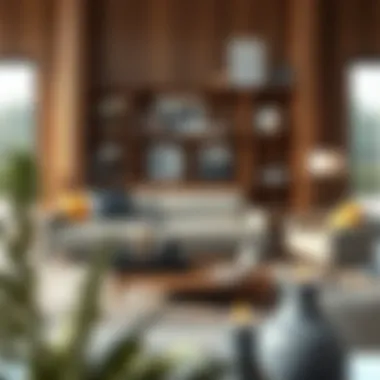
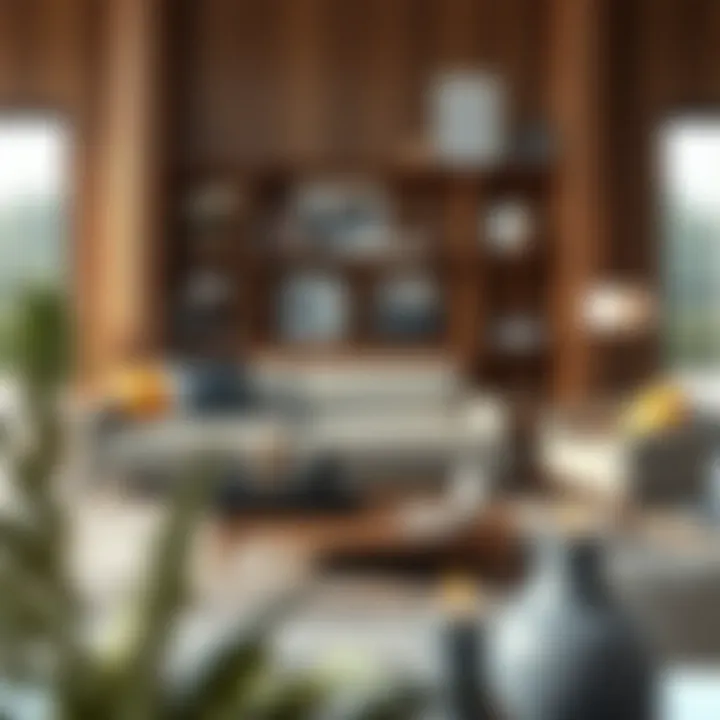
- Quality Over Quantity: Investing in well-made pieces often pays off.
- Resale Potential: Eco-friendly items can attract buyers willing to pay a premium.
- Timeless Design: Sustainable furniture tends to feature designs that age gracefully.
By making conscious choices about furniture, homeowners can create vibrant living spaces that reflect their values while ensuring that the future is a little brighter. Emphasizing sustainability doesn't mean adhering to a single mold; instead, it embodies creativity that aligns with one’s personal style.
Psychological Impact of Seating Arrangements
The configuration of our living spaces speaks volumes about how we wish to interact within them. Furniture does more than simply provide comfort; it greatly influences our behavior and emotional state. The choice and arrangement of sofas and coffee tables, specifically, can dictate the flow of conversation and the overall atmosphere of the room. Understanding the psychological impact of these design choices is essential for any homeowner or decorator looking to create an inviting environment.
Encouraging Conversation and Interaction
When sofas and coffee tables are arranged thoughtfully, they can foster an atmosphere where conversation flows naturally. For example, placing chairs in close proximity to a sofa, around a central coffee table encourages a more intimate setting. This arrangement draws people together, creating a circle or semi-circle that invites discussion. Conversely, a long, sprawling layout with the coffee table placed far from seating can discourage engagement, leaving individuals feeling isolated even in a shared space.
- Key considerations:
- Proximity: How close are the pieces to each other? Closer arrangements stimulate discussion.
- Orientation: Positioning sofas opposite one another can create a conversational setting that feels engaging.
- Size of the Coffee Table: If it is too big, it can create a barrier; too small might not be functional.
In informal settings like a family gathering, you might opt to use a round coffee table to keep the tone light and breezy. This choice instantly makes the environment feel less formal and more welcoming, allowing for spontaneous interactions. It's interesting to note that the choice of materials can also come into play. For instance, a wooden table gives a warm feel, while metal might convey a modern touch. Each choice subtly influences the mood.
Creating Comfort and Relaxation
There’s a huge difference between a space that feels welcoming and one that feels rigid. Sofas lined up against walls with coffee tables stuck in corners often exude a sense of formality that can make guests feel tense. Instead, creating a relaxed environment can be achieved through soft lines, inviting colors, and a layout that encourages lounging rather than just sitting.
To ensure comfort, consider the following:
- Soft Corners: Sofas with soft corners and plush cushions make the area more inviting.
- Layered Textiles: Using throw blankets or cushions can increase coziness and comfort.
- Lighting: Implementing varied light sources, like floor lamps around the sofa, can add warmth and encourage relaxation.
The interplay of these elements results in a space where individuals feel at ease, able to unwind after a long day. Just picture a cozy evening on a comfortable couch, with a low coffee table holding snacks and drinks, where friends can gather or family can bond seamlessly. The psychological effect of such arrangements speaks to the heart of what home is all about: comfort, connection, and relaxation.
"A well-designed living space enhances not only the aesthetics but significantly impacts our state of mind."
By paying close attention to how sofas and coffee tables interact, homeowners can harness their power to create environments that not only look great but feel right, making everyone feel at home.
Versatile Use of Coffee Tables
When it comes to furnishing your living space, the coffee table often takes on a role that extends far beyond merely holding drinks. Its multifaceted nature makes it a cornerstone of functionality and stylistic expression within the home. There’s a distinct importance in understanding how coffee tables can serve multiple purposes that contribute to both usability and aesthetic appeal in a room. The right coffee table can transform a simple seating area into a dynamic hub for interaction, creativity, and comfort.
Beyond Drinks: Multi-Functional Tables
While many may see coffee tables as a surface for placing beverages or snacks, they can actually be much more than just that. The trend of multi-functional tables is gaining traction, as people increasingly seek to maximize their space, especially in smaller homes or apartments.
Consider a coffee table that includes built-in storage or can expand to accommodate meals, games, or even work-from-home setups. Some tables come equipped with pop-up tops, allowing you to create a casual dining experience right in your living room. Others might slide open to reveal compartments where you can stow away magazines, remotes, or even your favorite board games.
- Versatility: This adaptability allows homeowners to rearrange and redefine their spaces according to their needs without purchasing new furniture.
- Enhanced Interaction: A multi-functional table encourages family and friends to gather, facilitating spontaneous gatherings right in the comfort of your own living room.
- Design Integration: A table that serves multiple purposes can align more closely with a homeowner's design vision, marrying form and function seamlessly.
"A coffee table should not just support the weight of your drink; it should elevate how you experience your space."
Storage Solutions: Hidden Features
Clutter can often make a room feel chaotic, affecting not just its appearance but also its overall functionality. Hidden storage solutions within coffee tables can play a significant role in maintaining a clean, organized environment. This practical aspect appeals to both aesthetics and practicality, allowing you to hide away unsightly items that can distract from your space’s overall design.
- Design Variety: Many coffee tables come with drawers, lift-tops, or nested designs, providing various options that can complement any decor style, from modern minimalist to rustic elegance.
- Easier Access: Consider choosing a design that allows easy access to all storage components, ensuring that your items are both hidden and reachable when needed.
- Functionality Meets Flair: It's essential to find a balance between hidden storage and the visual appeal of your coffee table. A table with beautiful woodwork and clever storage can add character while ensuring you have a place for everything.
For anyone looking to strike that balance between style and decluttering, investing in a functional coffee table is worthwhile. Whether it's through a piece that adapts to your lifestyle or one that cleverly conceals your essentials, the versatile use of coffee tables never goes out of style.
In a world where living spaces are often limited, a coffee table that serves multiple purposes can make a significant difference in how you experience your home. It’s not just about what you see, but how well each piece contributes to the overall harmony and fluidity of your space.
Future Trends in Sofa and Coffee Table Design
As society's needs evolve, so does the furniture that accompanies us in our homes. In this section, we navigate through the latest changes and predictions in sofa and coffee table design. Being in tune with future trends isn't just about keeping up appearances; it’s about adapting to a lifestyle that emphasizes comfort, sustainability, and technology. From innovative materials to shifting consumer preferences, each element plays a critical role in shaping our living spaces.
Innovative Technologies in Furniture
The marriage of technology and design is more than just a fleeting trend—it's reshaping how we interact with our furniture. Today, furniture makers are investing in smart technology to create pieces that not only serve aesthetic purposes but are also functional.
For instance, consider the introduction of coffee tables that charge your devices wirelessly or sofas equipped with built-in speakers. Such features not only enhance convenience but also foster a lifestyle that balances leisure with modern day demands.
Here are some pioneering innovations:
- Smart Materials: Many manufacturers are now utilizing materials that adjust based on temperature or can self-clean. This means your coffee table might not only look good but might also require less maintenance.
- Integrated Charging Stations: Tables that come with built-in USB ports or wireless charging pads mean fewer cords tangling across your living space.
- Virtual Reality: Some brands are experimenting with augmented reality to allow consumers to visualize how a specific piece will look in their home before purchase.
Being open to these technological advancements can transform a mundane living area into a modern, efficient space—making them a vital consideration in future trends.
Predicted Changes in Consumer Preferences
As the world around us transforms, so does the way we perceive and choose our furniture. Consumer preferences are pivotal in shaping market offerings, and they reflect deeper societal shifts. One notable trend is the increasing desire for multifunctional spaces; today’s homeowners often prioritize versatility due to compact living conditions.
Consider these evolving preferences in the realm of sofa and coffee table dynamics:
- Minimalism: In today’s fast-paced world, many individuals lean towards minimalist designs that convey simplicity and elegance. A clean-lined sofa paired with a sleek coffee table can create a visually appealing yet functional environment without clutter.
- Eco-Conscious Choices: Sustainability is top of mind for consumers. There's a growing demand for furniture that is both stylish and environmentally friendly. People prefer pieces made of recycled materials or sourced from sustainable practices.
- Personalization: Customization is becoming a must-have attribute. Shoppers are eschewing one-size-fits-all solutions in favor of products that allow them to express their identities. This spans from unique fabrics to customizable sizes.
Understanding these shifts means that brands must adapt, creating pieces that meld with evolving lifestyles and expectations. As a result, manufacturers who stay ahead of the curve can secure a loyal customer base, armed with knowledge of where the furniture landscape is heading.
"Furniture is the vessel of our memories, reflecting not only our tastes but also our evolving lifestyle needs."
In summary, the future of sofa and coffee table design is influenced by both technological advancements and shifting consumer nuances. Embracing these trends not only enhances design aesthetics but also aligns with practical living needs, ensuring spaces remain enjoyable and functional as times change.



